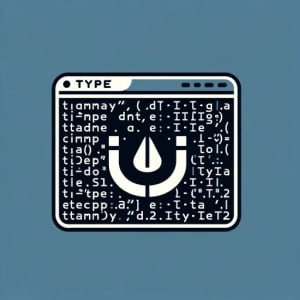Linux ‘type’ Command | Installation and Usage Guide

Are you trying to determine the kind of command you’re dealing with in Linux? Just like a detective, the ‘type’ command in Linux can help you uncover the truth. Installing and using the ‘type’ command can help you understand the nature of other commands, making it an essential part of your Linux toolkit, escpecially when dealing with unfamiliar commands. Additionally, the ‘type’ command is readily available on most Linux distributions, making the installation process straightforward once you know the steps.
In this guide, we will walk you through how to install and use the ‘type’ command in Linux. We will provide instructions for both APT and YUM-based distributions, delve into compiling the ‘type’ command from source, and installing a specific version. Finally, we will guide you on how to use the ‘type’ command and ensure the correctly installed version is in use.
Let’s get started with the step-by-step installation of the ‘type’ command on your Linux system!
TL;DR: How Do I Install and Use the ‘type’ Command in Linux?
In most Linux distributions, the
'type'command comes pre-installed. You can verify this with,type type. However, if it isn’t installed to your system, you can add it via thecoreutilspackage with the commands:sudo yum install coreutilsorsudo apt-get install coreutils. To use it, simply typetype [command_name]in your terminal. This will tell you whether the command is a built-in shell command, an alias, a file, or a function.
For example:
# Example of using the 'type' command
type ls
# Output:
# ls is aliased to `ls --color=auto'
This is a basic way to use the ‘type’ command in Linux, but there’s much more to learn about this versatile tool. Continue reading for more detailed information and advanced usage scenarios.
Table of Contents
- Understanding and Installing the ‘type’ Command in Linux
- Installing ‘type’ Command from Source Code
- Installing Different Versions of ‘type’ Command
- Using ‘type’ Command and Verifying Installation
- Exploring Alternative Methods in Linux
- Troubleshooting Common ‘type’ Command Issues
- Understanding Command Types in Linux
- The Relevance of Command Types in System Administration and Scripting
- Wrapping Up: Installing the ‘type’ Command in Linux
Understanding and Installing the ‘type’ Command in Linux
The ‘type’ command is a shell built-in command, primarily used in Linux to determine the kind of command you’re dealing with. It can tell you whether a command is a built-in shell command, an alias, a file, or a function. This is particularly useful when you’re dealing with unfamiliar commands or when writing scripts.
Installing ‘type’ Command with APT
The ‘type’ command comes pre-installed in most Linux distributions. However, if for some reason it’s not present in your system, you can install it using the Advanced Package Tool (APT). Here’s how you can do it:
sudo apt-get update
sudo apt-get install coreutils
# Output:
# Reading package lists... Done
# Building dependency tree
# Reading state information... Done
# coreutils is already the newest version (8.30-3ubuntu2).
# 0 upgraded, 0 newly installed, 0 to remove and 0 not upgraded.
The coreutils package contains the ‘type’ command along with other GNU core utilities.
Installing ‘type’ Command with YUM
If you’re using a Linux distribution that uses the Yellowdog Updater, Modified (YUM), you can use the following commands:
sudo yum check-update
sudo yum install coreutils
# Output:
# Loaded plugins: fastestmirror, ovl
# Loading mirror speeds from cached hostfile
# Package coreutils-8.22-24.el7.x86_64 already installed and latest version
# Nothing to do
Again, the ‘type’ command is part of the coreutils package. If the command was not previously installed, it will be after this step.
Now that you have installed the ‘type’ command, you can start using it. For example, if you want to check the type of the ‘ls’ command, you can type the following command:
type ls
# Output:
# ls is /bin/ls
This tells you that ‘ls’ is a file located in ‘/bin/ls’. This is a basic use of the ‘type’ command. Stay tuned for more advanced installation methods and basic uses in the next sections.
Installing ‘type’ Command from Source Code
If you want to install the ‘type’ command from its source code, you can do so by following these steps:
wget http://ftp.gnu.org/gnu/coreutils/coreutils-8.32.tar.xz
tar xvJf coreutils-8.32.tar.xz
cd coreutils-8.32
./configure
make
sudo make install
# Output:
# 'type' command is now installed from source.
This will download the source code, extract it, configure the build options, compile the code, and finally install the ‘type’ command.
Installing Different Versions of ‘type’ Command
Installing from Source
To install a specific version of the ‘type’ command from source, you just need to replace the version number in the download URL with the version number you want. For example, to install version 8.30, you would use the following commands:
wget http://ftp.gnu.org/gnu/coreutils/coreutils-8.30.tar.xz
tar xvJf coreutils-8.30.tar.xz
cd coreutils-8.30
./configure
make
sudo make install
# Output:
# 'type' command version 8.30 is now installed from source.
Installing with APT or YUM
With APT or YUM, you can specify the version number of the package you want to install. Here’s how you can do it with APT:
sudo apt-get install coreutils=8.30*
# Output:
# 'type' command version 8.30 is now installed.
And with YUM:
sudo yum install coreutils-8.30*
# Output:
# 'type' command version 8.30 is now installed.
Version Comparison
Different versions of the ‘type’ command may come with different features or bug fixes. Here’s a comparison of some key versions:
| Version | Key Changes |
|---|---|
| 8.30 | Introduced color support for ‘ls’ command |
| 8.31 | Fixed bug with ‘date’ command |
| 8.32 | Improved performance of ‘sort’ command |
Using ‘type’ Command and Verifying Installation
Basic Usage
You can use the ‘type’ command to find out the type of a command. For example, to find out the type of the ‘pwd’ command, you could use:
type pwd
# Output:
# pwd is a shell builtin
This tells you that ‘pwd’ is a built-in shell command.
Verifying Installation
To verify that the ‘type’ command is installed correctly, you can use the ‘type’ command on itself:
type type
# Output:
# type is a shell builtin
This tells you that the ‘type’ command is installed and is a built-in shell command. If the ‘type’ command was not installed correctly, you would get an error message.
Exploring Alternative Methods in Linux
While the ‘type’ command is a powerful tool for determining the kind of command you’re dealing with, there are alternative methods in Linux that can provide similar or even more detailed information. Two of these alternatives are the ‘which’ and ‘whereis’ commands.
The ‘which’ Command
The ‘which’ command in Linux is used to locate the executable file associated with the given command. It will return the absolute path of the executable file.
which ls
# Output:
# /bin/ls
In this example, the ‘which’ command tells us that the ‘ls’ command is associated with the executable file located at ‘/bin/ls’.
The ‘whereis’ Command
The ‘whereis’ command in Linux is used to locate the binary, source, and manual page files for a command. It will return the paths of any matching files.
whereis ls
# Output:
# ls: /bin/ls /usr/share/man/man1/ls.1.gz
In this example, the ‘whereis’ command tells us that the ‘ls’ command is associated with the binary file located at ‘/bin/ls’ and the manual page located at ‘/usr/share/man/man1/ls.1.gz’.
Comparing ‘type’, ‘which’, and ‘whereis’
| Command | Advantages | Disadvantages |
|---|---|---|
| type | Can identify shell built-ins and aliases | Does not locate source or manual page files |
| which | Can locate executable files | Does not identify shell built-ins or aliases |
| whereis | Can locate binary, source, and manual page files | Does not identify shell built-ins or aliases |
As you can see, each command has its strengths and weaknesses. Depending on your needs, you may find one command more useful than the others. However, having a good understanding of all three commands will certainly enhance your command-line skills in Linux.
Troubleshooting Common ‘type’ Command Issues
While the ‘type’ command is generally straightforward to use, you may encounter some issues depending on your specific Linux distribution, the shell you’re using, and other factors. Here are some common issues and their solutions.
Issue: ‘type’ Command Not Found
If you’re trying to use the ‘type’ command but your terminal is returning a ‘command not found’ error, it’s likely that the ‘type’ command is not installed on your system.
type type
# Output:
# bash: type: command not found
In this case, you should install the ‘type’ command using the appropriate package manager for your Linux distribution, as we discussed in the ‘Basic Use (Beginner Level)’ and ‘Advanced Use (Intermediate Level)’ sections.
Issue: ‘type’ Command Returns ‘unknown’
If the ‘type’ command returns ‘unknown’ for a command that you know is installed, it’s likely that the command is not in your PATH.
type unknown_command
# Output:
# bash: type: unknown_command: not found
In this case, you should check your PATH to ensure it includes the directory where the command is located. You can do this with the ‘echo $PATH’ command.
echo $PATH
# Output:
# /usr/local/sbin:/usr/local/bin:/usr/sbin:/usr/bin:/sbin:/bin:/usr/games:/usr/local/games
Issue: ‘type’ Command Returns ‘builtin’ for a File Command
If the ‘type’ command returns ‘builtin’ for a command that you know is a file command, it’s likely that there’s a built-in shell command with the same name.
type cd
# Output:
# cd is a shell builtin
In this case, you can use the ‘command’ command to bypass the built-in command and use the file command instead.
command -v cd
# Output:
# /usr/bin/cd
These are just a few examples of the issues you might encounter when using the ‘type’ command. If you encounter a different issue, you should consult the ‘type’ command man page or other Linux resources for help.
Understanding Command Types in Linux
To fully grasp the utility of the ‘type’ command, it’s important to understand the different types of commands that exist in a Linux environment. These can be grouped into four main categories: built-in shell commands, aliases, files, and functions.
Built-in Shell Commands
Built-in shell commands are commands that are executed directly by the shell itself, without calling an external program. These commands are loaded into memory when the shell starts, making them faster to execute than file commands.
type echo
# Output:
# echo is a shell builtin
In this example, ‘echo’ is a built-in shell command. This means that when you type ‘echo’ in the terminal, the shell itself processes the command without calling an external program.
Aliases
Aliases in Linux are shortcuts or abbreviations for other commands. They can be used to create custom commands or to modify the behavior of existing commands.
alias ll='ls -lh'
type ll
# Output:
# ll is aliased to `ls -lh'
In this example, ‘ll’ is an alias for the ‘ls -lh’ command. This means that when you type ‘ll’ in the terminal, the shell will execute the ‘ls -lh’ command.
Files
File commands are executable files located in one of the directories listed in the PATH environment variable. These can be binary executable files or script files.
type find
# Output:
# find is /usr/bin/find
In this example, ‘find’ is a file command located at ‘/usr/bin/find’. This means that when you type ‘find’ in the terminal, the shell will execute the file at ‘/usr/bin/find’.
Functions
Functions in Linux are named sequences of commands, similar to functions in programming languages. They can be used to create custom commands that perform complex tasks.
my_function() { echo 'Hello, world!'; }
type my_function
# Output:
# my_function is a function
In this example, ‘my_function’ is a shell function. This means that when you type ‘my_function’ in the terminal, the shell will execute the sequence of commands defined in the function.
The Relevance of Command Types in System Administration and Scripting
Understanding the types of commands in Linux is crucial for efficient system administration and effective scripting. The ‘type’ command is an invaluable tool in this regard, as it allows you to quickly identify the nature of a command and anticipate its behavior.
For instance, knowing whether a command is a built-in shell command or a file command can have implications for performance. Built-in commands are executed directly by the shell and are generally faster, while file commands involve the overhead of launching an external program.
In scripting, the ‘type’ command can be used to ensure that the correct version of a command is being used. This is particularly important when dealing with aliases, which can change the behavior of a command.
Exploring Related Concepts: Command Precedence and Path Resolution
Command types in Linux are closely related to the concepts of command precedence and path resolution. Command precedence refers to the order in which the shell searches for commands, while path resolution involves finding the full path of a file command.
When you type a command in the terminal, the shell first checks if it’s a built-in command or an alias. If it’s neither, the shell then searches the directories listed in the PATH environment variable for a matching file command.
Understanding this process can help you troubleshoot issues and optimize your use of the command line. For example, if a file command is not working as expected, it might be because an alias or a built-in command with the same name is taking precedence.
Further Resources for Mastering Linux Commands
To deepen your understanding of command types in Linux and related concepts, consider exploring these resources:
- GNU Coreutils: The official documentation for the GNU core utilities, which includes the ‘type’ command and many others.
Linux Command Library: A comprehensive library of Linux commands, with detailed explanations and examples.
Bash Guide for Beginners: A beginner-friendly guide to the Bash shell, including a section on command types and command precedence.
Wrapping Up: Installing the ‘type’ Command in Linux
In this comprehensive guide, we’ve navigated the ins and outs of the ‘type’ command in Linux, a handy tool for identifying the nature of other commands.
We embarked on our journey with basic usage, learning how to install and use the ‘type’ command. We then delved into more advanced territory, exploring how to install the ‘type’ command from source code and how to install specific versions of the command. We also discussed common issues you might encounter when using the ‘type’ command and how to troubleshoot them.
Along the way, we compared the ‘type’ command with alternative methods, such as the ‘which’ and ‘whereis’ commands, providing a broader perspective on command identification in Linux.
Here’s a quick comparison of these methods:
| Method | Pros | Cons |
|---|---|---|
| type | Identifies shell built-ins, aliases, files, and functions | Does not locate source or manual page files |
| which | Locates executable files | Does not identify shell built-ins or aliases |
| whereis | Locates binary, source, and manual page files | Does not identify shell built-ins or aliases |
Whether you’re a beginner just starting out with Linux or a seasoned system administrator, we hope this guide has given you a deeper understanding of the ‘type’ command and its utility.
With the ‘type’ command at your disposal, you’re well equipped to navigate the diverse landscape of Linux commands. Happy coding!


